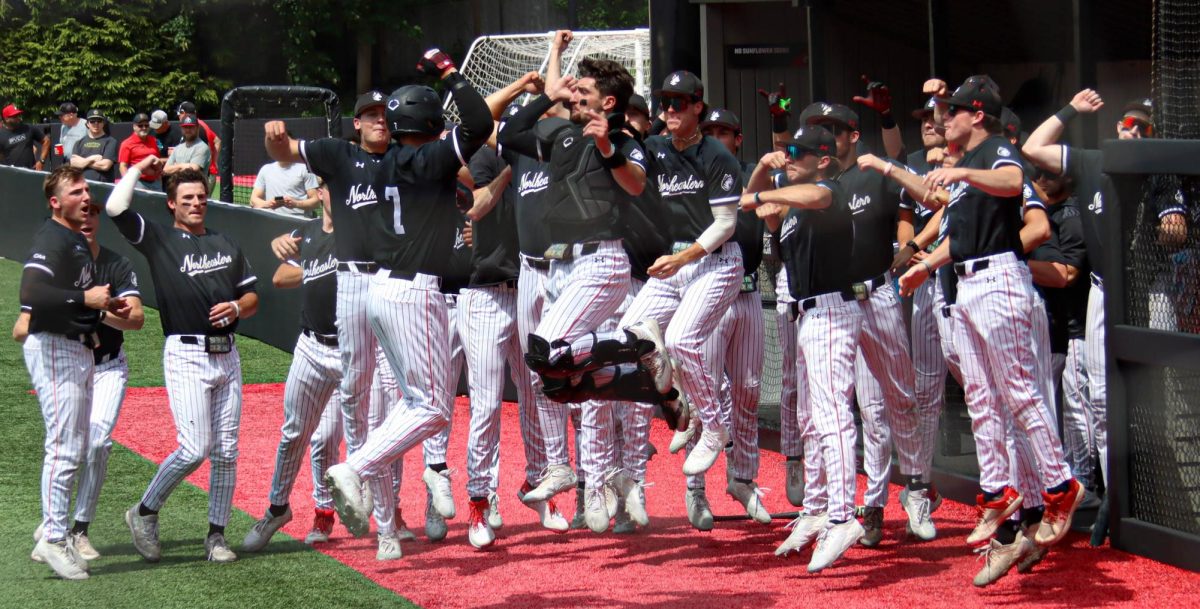Head coaches of Northeastern’s men’s sports teams made, on average, $109,000 more than head coaches of women’s sports teams during the 2024 fiscal year, or FY 2024, according to an annual survey and report published by the university’s athletic department.
In FY 2024, the average salary for the head coach of a men’s team was $250,757. The average head coach of a women’s team made $141,541 — a $109,216 disparity. It’s the largest the discrepancy has been since 2020, when the average salary of men’s team head coaches was $121,782 more than that of a women’s team. And compared to peer institutions, Northeastern’s pay gap is one of the highest.
Last year, men’s team head coaches made, on average, $69,504 more than those of women’s teams.
Both head and assistant coaches of men’s teams and women’s teams saw increases in average salaries from last fiscal year, but the average salary for head coaches of men’s teams saw a significantly larger jump. During FY 2024, head coaches of women’s teams made, on average, roughly $8,000 more than the year before and head coaches of men’s teams made roughly $48,000 more.
According to the survey, the average men’s team assistant coach made $7,614 more than their women’s team counterparts in FY 2024.
The data is one small part of the university’s annual Equity in Athletics Disclosure Act, or EADA, survey, which Northeastern published online Oct. 14. The survey also includes figures for revenues and expenses for each team, student aid and recruiting.
The EADA survey data encompasses all of Northeastern’s varsity sports teams, of which six are men’s and eight are women’s. While Northeastern has 17 teams, for salary, expense and revenue calculations, the survey combines certain genders’ respective programs such as cross country and track and swimming and diving.
The university’s co-ed esports team, with 33 men and two women, is included in the survey as well. According to the survey, the men’s teams are led by six head and 22 assistant coaches and the women’s teams by eight head and 30 assistant coaches.
The survey shows that 260 student athletes participated in men’s teams and 274 participated in women’s teams, a total of 534 students. While nearly all participants played on the team of the gender they identified with — male-identifying students played on men’s teams and vice versa — the men’s rowing team had four female coxswains on its roster. One-hundred and forty-two student athletes participated in more than one sport.
The number of athletes resembles last year’s data with this year’s survey showing slightly more participants on both men’s and women’s teams.
The EADA, passed in 1994, requires coeducational higher education institutions that receive Title IV federal student aid and have intercollegiate athletics programs to publish both their responses to the EADA survey and report annually. The act was designed to promote “equitable athletic opportunities for [higher education’s] men and women students,” according to the Department of Education.
EADA data typically encompasses a university’s fiscal year, in this case spanning from July 1, 2023 to June 30, 2024.
The university did not answer The News’ questions on who oversees team funding and coaching salaries. As a result, it’s not exactly clear who gets final say on university athletic finances.
Assistant Athletic Director of Business and Finance Dan Brem has served in his role since 2017, where he “develops and manages the overall operating budget for the athletic department, including payroll, travel, accounts payable and budget management and control.”
Director of Athletics and Recreation Jim Madigan oversees the athletic department, but athletics is overseen by the office of Chancellor and Senior Vice President for Learning Ken Henderson.
The News reached out to Brem, Henderson and Madigan for interviews, but was directed to Northeastern’s media relations team.
In response to several questions about how pay is determined, how funds are allocated across teams and if the university has any plans to address the $100,000 disparity, the media relations team sent a two sentence statement.
“Northeastern remains committed to providing competitive compensation and benefits for employees across its global network of campuses,” the statement from Vice President for Communications Renata Nyul said. “The university considers a broad range of factors, consistent with state and federal laws regarding gender parity, to determine appropriate compensation.”
The disparity between pay for men’s and women’s head coaches is not unique to Northeastern.
When comparing the Northeastern salary rates to other Coastal Athletic Association, or CAA, teams, the NCAA Division 1 conference several Northeastern teams are a part of, a similar discrepancy exists between men’s team coaches and women’s teams coaches.
But Northeastern’s disparity is the third-highest in the conference based on schools who have recently published their surveys or reports, per a Huntington News analysis of CAA institutions’ EADA surveys.
At Stony Brook University and the College of Charleston, both members of the CAA, the discrepancies between men’s and women’s teams head coaches was roughly $114,000, according to their FY 2024 surveys. The two institutions have the highest disparity in the CAA and are the two school’s with larger gaps than Northeastern.
During FY 2024, Elon University’s discrepancy was roughly $88,000, at University of North Carolina Wilmington it was $78,447 and at Drexel University it was about $31,000.
At both Monmouth University and The College of William & Mary, men’s team head coaches were paid an average of roughly $50,000 more than their women’s team counterparts, according to their most recent, publicly available surveys from FY 2022 and FY 2023, respectively. The two institutions have yet to post their FY 2024 surveys online as of Oct. 29.
None of the remaining CAA institutions have appeared to published online EADA surveys since 2021.
At Boston University — which is not in the CAA, but competes as a key Northeastern rival in Hockey East — the discrepancy between the average head coach of a men’s team and women’s team in FY 2023 was $67,267.
While the average salaries of head coaches for men’s and women’s teams vary greatly between the sport and institution, Northeastern’s head coaches tended to be paid higher than or around the same as head coaches at the above universities. Based on their respective surveys, average pay for men’s teams was roughly $178,000 and women’s teams $104,000 at the schools listed above.
Compared to those same universities, the $7,600 disparity between Northeastern men’s team and women’s team assistant coaches is the smallest. Based on those institutions’ respective surveys, the average discrepancy between assistant coaches for men’s and women’s teams was roughly $20,000 — significantly larger than at Northeastern. Northeastern assistant coaches for men’s teams made, on average, around $1,000 less than those at the universities listed above, and women’s teams assistant coaches made, on average, $13,000 more.
Other athletic department data
Northeastern’s top-expenditure teams were its men’s basketball and ice hockey teams. The university spent roughly $3.8 million on each team in total expenses, according to the survey. The Northeastern women’s ice hockey and basketball teams were the top-funded women’s teams at the university, with the university spending $3.05 million on ice hockey and $2.8 million on basketball, per the survey’s total expenses sections.
The survey defines total expenses as “all expenses attributable to intercollegiate athletic activities.”
Northeastern spent $2.75 million on its men’s teams and $2.24 million on its women’s teams for game day, or operational, expenses, — defined as “all expenses an institution incurs attributable to home, away, and neutral-site intercollegiate athletic contests.” Divided by the teams’ participants, that’s an average $9,055 for participants on men’s teams and $6,646 for those on women’s teams.
The year before, Northeastern spent about $3.05 million on its men’s teams and $2.37 million on its women’s teams for game day expenses — about $9,700 per participants on men’s teams and $7,400 per participants on women’s teams.
Women’s teams spent just under $260,000 on recruiting — which includes lodging, meals, transportation and other expenses for official and unofficial visits for the purposes of recruiting — compared to the men’s teams’ $230,600.
Recruiting expenses for both men’s and women’s teams were both significantly higher than the year before.
The survey also shows that throughout FY 2024, women’s teams spent roughly $8.76 million on athletic-related student aid compared to the men’s teams’ $7.32 million.
Last year, women’s teams spent roughly $8 million on student aid, while men’s teams spent around $6.6 million.
The survey shows that both the six men’s and eight women’s teams earned roughly $15 million in total revenue. Including roughly $8.5 million that were not allocated to specific teams, Northeastern’s total revenue was about $39 million. The year before, both men’s and women’s teams each earned around $14 million.
For the purposes of EADA reporting, this includes revenue from “appearance guarantees and options, an athletic conference, tournament or bowl games, concessions, contributions from alumni and others, institutional support, program advertising and sales, radio and television, royalties, signage and other sponsorships, sports camps, state or other government support, student activity fees, ticket and luxury box sales, and any other revenues attributable to intercollegiate athletic activities.”
The survey requires that revenue must exceed or match expenses, and it does not make any distinction between allocated revenues — funds the university allocates to a team — and earned revenues — funds the team earns throughout the year through ticket sales, concessions, donations, etc.
As shown in the survey, Northeastern’s expense figures for each team matched exactly with each team’s revenue.
As Ted Tatos, an expert in higher education athletic finances, explains, it becomes difficult to determine when a team has earned revenue versus when it is allocated to a team by the university.
“The main limitation of EADA data is its failure to separate earned vs. allocated revenues, likely precluding a determination of athletic department profitability based on these data for researchers interested in such a figure,” Tatos wrote in a study examining how universities report athletic financial data.
As a result, the survey doesn’t clearly define the relationship between how much a team earns and how much a university spends on a team.
“Because these data do not separate allocated and earned revenues, researchers generally cannot rely on EADA survey data alone to determine instances where individual athletic department earned revenues (excluding institutional aid) exceeded expenses, rendering the department ostensibly ‘profitable,’” Tatos wrote. “Often, such institutional support is used to cover the shortfall between earned athletic revenues and athletic expenses, when the latter exceeds the former, as it does at many institutions.”
Northeastern’s FY 2025 EADA survey, a fiscal year for which the university has announced significant budget cuts, is likely to be available around Oct. 15 of next year.
The Huntington News is dedicated to serving the Northeastern University community with original, professional reporting and creating an environment in which student journalists can learn from one another. Support an independent, free press at Northeastern University with your donation today.











